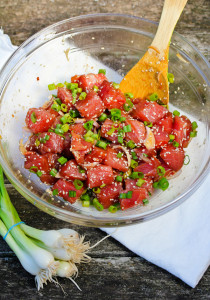A true fusion, Hawaiian cuisine is influenced by the food cultures that immigrant workers brought from China, Korea, Japan, the Philippines and Portugal. Combined with existing indigenous ingredients, as well as European and American foods, a style unique to Hawaii was born. In fact, it was so distinct that in 1992, a group of Hawaiian chefs worked together to establish the “Hawaii Regional Cuisine” culinary movement, putting a name to their style of cooking that made use of locally grown ingredients and focused on the blending of diverse culinary influences present on the islands.
Here on the mainland, Hawaii’s biggest culinary success has undoubtedly been poke (pronounced PO-kay) — the simple and sneakily addictive raw fish salad often served as an appetizer in Hawaiian cuisine. It certainly isn’t a new creation, originating from fishermen who would snack on trimmings of the fish they caught that day, but poke seems to be enjoying a serious moment  across the country. The dish has become wildly popular in recent months, with versions of it popping up all over menus in New York, Los Angeles and everywhere in between. And now, an abundance of poke dishes have surfaced in North Jersey.
across the country. The dish has become wildly popular in recent months, with versions of it popping up all over menus in New York, Los Angeles and everywhere in between. And now, an abundance of poke dishes have surfaced in North Jersey.
The word poke means “cut” or “section” in Hawaiian, and that’s exactly what the dish is: Pieces of raw fish cut into cubes, tossed with a dressing of some kind — such as the classic combination of soy sauce and sesame oil, and garnished with any number of toppings. Poke is most often made using raw yellowfin (ahi) tuna, but other adaptations may feature salmon, whitefish or even octopus. Each element of the dish works to elevate the others: The sweetness of the fresh raw fish combined with the saltiness of the sauce and a touch of oil works to build an enticing bowl rich in both flavor and protein.
